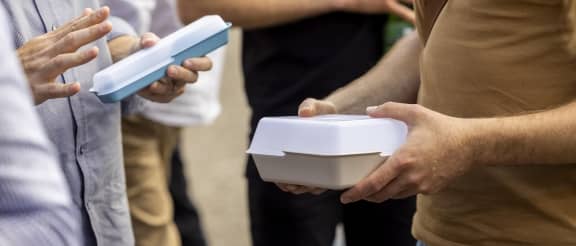KIDV continues as Verpact
November 6, 2025
Over the past year, as part of the Community of Practice Reusable Packaging, the Netherlands Institute for Sustainable Packaging (KIDV) has held a triptych of webinars on the use of reusable packaging and systems in other countries: what are relevant developments and what can we learn from them in the Netherlands? After zooming in on frontrunners France and Germany respectively, the focus during the last webinar on 10 November 2022 was on the developments within the United Kingdom (UK).
Catherine Conway - founder and director of Unpackaged Innovation Ltd. - opened the webinar by explaining the context of packaging in the UK. "Despite being the second largest producer of plastic packaging in the world and the UK government's ambition to reduce packaging in the market, there are currently no official targets. However, the government is expanding producer responsibility and introducing a deposit system for single-use beverage containers. Most agreements around reducing plastic are still voluntary though, such as the Plastic Pact."
That said, Conway does see that the use of reusable packaging is gaining more traction. "More British consumers are willing to use reusable packaging. However, a shared infrastructure is still lacking within the UK, so pilots are often fragmented. More collaboration is needed to scale up pilots. Not only in the UK, but also on a European and global level." With the Refill Coalition - a coalition of leading UK retailers - Conway is trying to make the whole system more accessible. She does this by expanding the use of dispensers. "We have adapted the design of the dispensers, allowing them to be used by different manufacturers. Clean dispensers are filled by the supplier and brought to the retailer. There, consumers can fill their reusable container. Empty dispensers go back to the distribution centre, where we pick them up and then clean them. A key advantage of the dispensers is that they are all standardised. Moreover, they are cost-efficient and take up less space during transport than current models and single-use containers. The dispensers are currently filled with dry products, but they are also designed for liquids. We will be working on that in the coming months."
The presenation of Catherine Conway can be found here.
Next up is Paul Garner, senior commercial manager at Asda Stores Limited. He too talks about a pilot on reusable packaging. Garner: "In 2020, we launched a sustainable shop in Leeds. A year later, we opened three more shops in York, Milton Keynes and Glasgow. In these shops, consumers can fill their own food containers with different dry goods, such as pasta, cereals and rice. The pilots demonstrate that it works better - for both consumers and the shops themselves - to set up a dedicated corner where consumers can fill their containers instead of placing refill stations by the relevant product category in the shop. The pilots also show that consumers prefer prefill when it comes to wet products such as detergents. The biggest obstacles are convenience and price. This is because the price per product at the refill stations differs from the price per packaging in the rest of the shop, which made it difficult for consumers to compare prices." Garner concludes his presentation with follow-up steps Asda will take: "We are going to ensure that the refill stations are always cheaper than pre-packaged products, which will make price comparison significantly easier. We will also set up reusable zones in all pilot shops and - based on our findings from the pilots - focus on four product categories in the coming period: pet food, coffee and tea, confectionery and dry products such as rice, pasta and breakfast cereals. We had expected baking products to also be a suitable category, but the pilots demonstrate that this is not the case."
The presenation of Paul Garner can be found here.
Ben Patten, founder of Dizzie, delivers the final presentation of the webinar. "Dizzie delivers groceries in reusable packaging, both to consumers and retailers. Our first packaging took up too much space and all looked very similar, making it difficult for consumers to tell them apart. We therefore made them stackable and added coloured labels. In the end, this also saves transport costs." He continues his presentation with the importance of a sound IT infrastructure: not only does this save Dizzie up to 80 per cent in costs, but it can also help increase the packaging return rate. Patten concludes his presentation with an advantage - which he believes is not often talked about - of reusable packaging: "They have a significant commercial advantage these days. Indeed, at the retailer we work with, we see a loyal and fast-growing customer base. Because of this growth potential, I therefore encourage retailers and start-ups to remain persistent on reusable."
To further explore common challenges and opportunities of reusable packaging, KIDV has established the Community of Practice Reusable Packaging in 2019. It brings together parties that are working to make their packaging more sustainable by studying and implementing reusable options. Participants include supermarkets, brand owners, service providers, start-ups, knowledge institutions and NGOs. From the CoP Reusable Packaging emerged Planet Reuse, the first European network to accelerate the implementation and scale-up of reusable packaging models.
Click here for more information about the CoP Reusable Packaging. More information on Planet Reuse can be found here.
